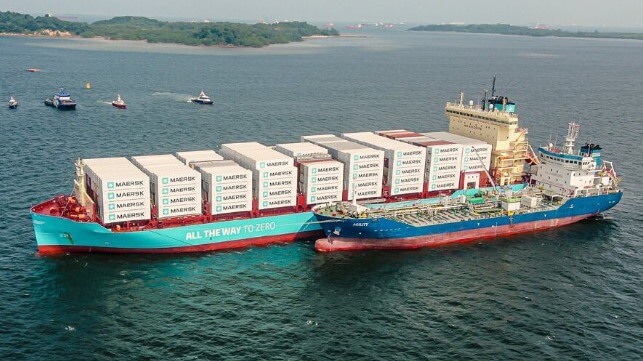Singapore-Rotterdam Green Corridor Targets Up To 30% GHG Reductions

The partners working to establish the so-called “green corridor” between Singapore and Rotterdam met for their third workshop session in the year since the plan was first unveiled. They report strong progress as they work to launch what could be a pioneer in the concept and serve as a model for a multitude of similar projects in the planning stages.
The idea for green corridors to accelerate decarbonization was initially launched at the UN’s COP 26 event in Scotland in November 2021. A total of 22 nations signed the initial decree, pledging to support the launch of net-zero corridors. Some of the early predictions were for short sea routes, but one of the longest possible routes linking the world’s two largest bunkering ports is leading the development.
Organizers highlight that smaller initiatives are already underway to lay the groundwork for functions such as bunkering while committees and studies are underway identifying the key challenges and laying the framework for the corridor. For example, they point out that Singapore and then Rotterdam were recently two of the first ports in the world to participate in the green methanol bunkering of a containership. The ship, the Laura Maersk, called in both ports during her delivery from South Korea to Denmark and will continue to bunker in Rotterdam approximately every five weeks after entering commercial service in October.
The Rotterdam-Singapore corridor was first announced in August 2022 as the Green & Digital Shipping Corridor. Over the past year, the corridor attracted strong support from global value-chain partners, including shipping lines, port authorities and operators, fuel suppliers, fuel coalitions and associations, banks, leading institutes of higher learning, and knowledge partners.
The project partners are working towards reducing greenhouse gas emissions on this international shipping corridor by 20 percent while striving for 30 percent by 2030, compared to 2022. The first phase toward net-zero they point out will be achieved through the development and uptake of zero and near-zero emission fuels in containerships with a capacity of at least 8,000 TEU deployed on the 15,000 km route, supported by a combination of operational and digital efficiencies.
A modeling study led by the Maersk Mc-Kinney Møller Center for Zero-Carbon Shipping, one of the corridor partners for the project, and supported by the ports, explored multiple alternative fuels across a variety of zero and near-zero emission pathways, including synthetic and bio-variants of methanol, ammonia, and LNG. Efforts are underway to aggregate demand and supply to reduce the cost gap towards the adoption of sustainable fuels and longer term they plan on expanding the study to hydrogen as another alternative fuel pathway.
Working groups have been established to look into the deployment of all of these fuels on the trade lane, spanning across demand and supply of fuel, standards, safety procedures, financing, and regulations. The corridor partners gathered in Rotterdam this week to identify action steps for the various fuel pathways.
Low-carbon fuels they recognize will likely be more expensive than existing fuels. Therefore, a separate working group has been formed with the support of the Global Maritime Forum, the Centre for Maritime Studies of the National University of Singapore, the University of Oxford, and Citi, to address gaps in regulation and financing. The study includes modeling price-gap differences to incentivize the uptake of alternative fuels.

that matters most
Get the latest maritime news delivered to your inbox daily.
Singapore and Rotterdam also continue to jointly assess the readiness of both ports to support the initiative. They point to efforts such as adopting similar bunkering standards and safety frameworks to accelerate the adoption of zero and near-zero emission fuels.
The partners believe that the corridor’s approach, supported by the strong industry coalition will provide greater certainty in demand and help scale-up production of zero and near-zero emission fuels. They also believe the corridor will fulfill the original mission for the concept to provide models for the wider adoption of net-zero initiatives.
